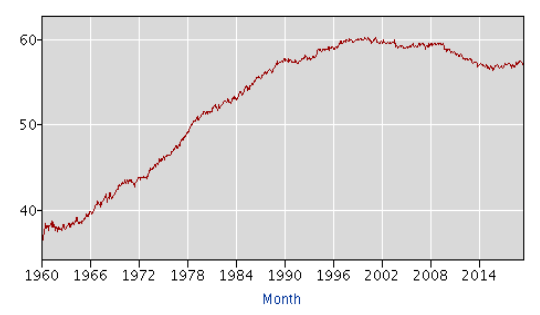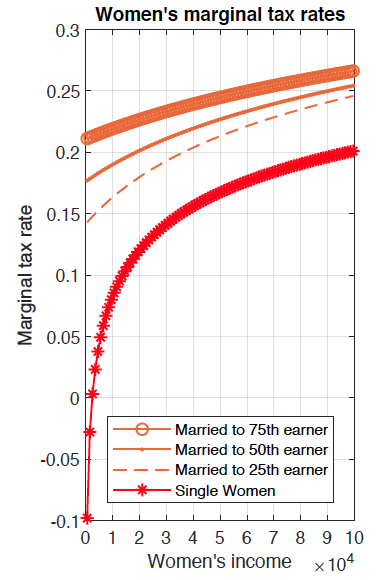After increasing robustly from 1962 to the early 1990s, the labour force participation of women in the US has been stagnating (Figure 1). Black et al. (2017) write: “The US economy will not operate at its full potential unless government and employers remove impediments to full participation by women in the labor market. The failure to address structural problems in labor markets – including tax and employment policy – does more than hold back women’s careers and aspirations for a better life. In fact, barriers to participation by women also act as brakes on the national economy, stifling the economy's ability to fully apply the talents of 51 percent of the population.”
Figure 1 Labour force participation rate of women aged 16 and older in the US
Source: Bureau of Labour Statistics from the Current Population Survey
In the US, taxes and old-age Social Security benefits depend on one’s marital status and tend to discourage the labour supply of the secondary earner. Lower wages indicate that these secondary earners have historically been women.
The disincentives from joint taxation arise because couples file taxes jointly and taxation is progressive. As a result, secondary earners face a higher marginal tax rate, which discourages their labour supply. This is because the marginal tax rate (i.e. the tax rate applied to an additional dollar of income, computed at different income levels) is a very important determinant in the decision to return to working.
The disincentives to work related to Social Security benefits stem from the fact that married and widowed people can claim Social Security spousal and survivorship benefits using their spouses’ past contributions rather than their own. That is, Social Security benefits for a married person are the higher between one’s own benefit entitlement and half of the spouse’s entitlement while the other spouse is alive (spousal benefit) and the higher between one’s own benefit entitlement and the deceased spouse’s after the spouse’s death (survival benefit). This implies that the lower labour supply of the secondary earner does not necessarily imply lower Social Security benefits.
In a recent paper (Borella et al. 2019), we measure these disincentives and estimate a life-cycle model to study the extent to which marriage-based taxes and Social Security benefit rules affect labour supply and savings.
To get a better sense of the magnitude of these disincentives, Figure 2 plots four marginal tax rates as a function of women's earnings. They refer to people born in 1945 in calendar year 1988, and to the marginal tax rates of single women and married women with husbands at three different earnings percentiles. For instance, a single woman earning $500 a year faces a marginal tax rate of -10% (also owing to the Earned Income Tax Credit), whereas a married woman earning the same amount faces a marginal tax rate of 14%, 18%, and 21% if she is married to a man in the 25th, 50th, and 75th income percentiles, respectively. This suggests that making married people file as single rather than jointly would imply much lower marginal tax rates for women and could thus have large incentives with respect to their labour market participation.
Figure 2 Marginal tax rate when single (starred red line), married to a man at the 25th (dashed orange line), 50th (dotted orange line), and 75th (circled orange line) income percentiles, plotted as a function of women's earnings in 2016 dollars
The left panel of Figure 3 plots Social Security benefits at the household level while the husband is alive. It takes data from married women at retirement age and, based on the deciles of their own Social Security entitlement, plots their average household yearly Social Security benefits with (circled line) and without (crossed line) marital benefits. For instance, the number 1 on the horizontal axis represents married women aged 66 in our 1945 cohort that are in the lowest decile of their own Social Security contributions. At that decile, household Social Security benefits for those women and their husbands are $32,000 under marital benefits and $22,000 without marital benefits. A comparison of the two lines in this picture reveals that about 50% of married households benefit from Social Security marital benefits while their husband is alive and that these benefits can be very large.
The right panel of Figure 3 takes data from the same married women and plots what their own yearly Social Security benefits would be after their husband’s death with and without survivor’s benefits. For instance, a 66 year-old married woman at the lowest 10% of Social Security contributions, once a widow, would receive less than $500 a month based on her own contributions, whereas she receives $22,000 thanks to her husband’s contributions and survivorship benefits. The picture shows that, because the potential wages of most women are lower than men’s, and because women participate less in the labour force and work fewer hours, survivorship benefits are large for over 80% of married women in this cohort. This last set of graphs highlights that Social Security marital benefits are large and can also reduce married women’s incentives to work.
Figure 3 Average household Social Security benefits at age 66 by wife’s own Social Security benefit decile, with (dotted blue line) or without (starred red line) marital benefit, in 2016 dollars.
Notes: Left panel: Social Security benefits at the household level while the husband is alive. Right panel: Average survivor benefit by wife’s own Social Security benefit decile, with (dotted blue line) or without (starred red line) marital benefits, 2016 dollars.
To evaluate the effect of marriage-related taxes and Social Security benefits on female labour supply, we estimate a rich quantitative lifecycle model of labour supply and savings with single and married people who face a possible change in marital status. The model incorporates skill building on the job and includes medical spending and longevity risk. Importantly, our model not only fits the observed data on labour supply and savings for single and married men and women over the life cycle, but also implies realistic responses of participation and hours worked in the labour market when net wages change (labour supply elasticities).
Using our model, we find that marriage-based taxes and Social Security benefits strongly reduce female labour supply. The elimination of these marriage-based rules would have raised participation at age 25 by over 20 percentage points for married women and by 5 percentage points for single women. At age 45, participation for these groups would have been, respectively, 15 and 3 percentage points higher without these marriage-related provisions. In contrast, the elimination of these marriage-based rules would reduce the participation of married men starting at age 60, resulting in a participation rate that is 8 percentage points lower by age 65.
We also show that, if the government surplus resulting from the elimination of marriage-related provisions were used to lower income taxation, the vast majority of the population would reap large welfare gains, and the few households that would lose would experience small welfare losses.
These results refer to the cohort born around 1945. Given that the labour supply of married women has been increasing rapidly over time for cohorts born before the 1970s, a natural question that arises is whether the effects of these marital provisions are also large for younger cohorts in which married women are more likely to work. To shed light on this question, we also study a cohort that is ten years younger and for which we still have a labour market history. Importantly, their labour supply behaviour is quite similar to that of younger cohorts. We find that even for the 1955 birth cohort, the effects of eliminating marriage-based taxation and Social Security benefits are large. A revenue-neutral reform (that is, one that reduces the proportional component of the income tax to balance the government budget, arising from the cost savings from the elimination of marital Social Security benefits) would be welfare improving for the vast majority of people in this cohort.
References
Black, S E, D Whitmore Schanzenbach and A Breitwieser (2017), “The recent decline in women’s labor force participation”, in Whitmore Schanzenbach, D and R Nunn (eds), in The 51%: Driving growth through women’s economic participation, Brookings, The Hamilton Project.
Borella, M, M De Nardi and F Yang (2019), “Are marriage-related taxes and social security Benefits holding back female labor supply?” NBER working paper 26097.









